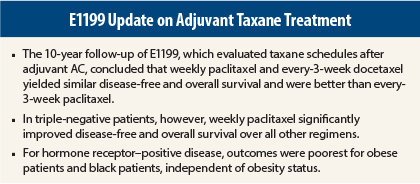An update of clinical trial E1199 showed that weekly paclitaxel and every-3-week docetaxel were both more effective than every-3-week paclitaxel in preventing deaths and tumor recurrences, according to Joseph Sparano, MD, Professor of Medicine and Women’s Health at the Albert Einstein College of Medicine, New York, who presented a 10-year update of E1199 at the 2014 San Antonio Breast Cancer Symposium.1
E1199 compared the efficacy of the two taxanes, in two different schedules, in the adjuvant treatment of 4,950 women with axillary node-positive or high-risk node-negative tumors. Patients were randomized to receive 4 cycles of doxorubicin and cyclophosphamide (AC) every 3 weeks, followed by either paclitaxel or docetaxel, either weekly or every 3 weeks. The weekly doses were 80 mg/m2 of paclitaxel and 35 mg/m2 of docetaxel, whereas the every-3-week doses were 175 mg/m2 and 100 mg/m2, respectively.
The current analysis was performed after 12.1 years of follow-up; the prior analysis was at 5.3 years.2
Every-3-Week Paclitaxel Not as Effective
“In the entire population, adjuvant weekly paclitaxel and every-3-week docetaxel were associated with significantly improved disease-free survival and marginally improved overall survival compared with every-3-week paclitaxel, when given sequentially after adjuvant AC,” Dr. Sparano reported.
There was no difference between the combined paclitaxel arms and the combined docetaxel arms in terms of disease-free or overall survival. There was also no difference in the combined weekly vs combined every-3-week arms.
Triple-Negative, Hormone Receptor–Positive Disease
For the 1,025 patients with triple-negative disease, however, the most effective taxane regimen was weekly paclitaxel. With this regimen, 10-year disease-free survival improved to 69%, from 59% with every-3-week paclitaxel, 57% with weekly docetaxel, and 62% with every-3-week docetaxel (P = .032). The overall survival improved to 75% from 66%, 69%, and 69%, respectively (P = .094), Dr. Sparano reported.
For hormone receptor–positive, HER2-negative/unknown disease, there was a trend toward improved outcomes for the experimental taxane arms seen at 5 years and consistently observed at 10 years. “But attention to extended adjuvant endocrine therapy may be more relevant in this population, who have a risk for late relapse,” he suggested.
Strong associations with inferior outcomes were observed for patients who were obese or black (independent of obesity), confirming previous reports. Nonobese black patients had more than a doubling in the risk for disease progression and death.
Room for Improvement
Although AC followed by weekly paclitaxel appears to be the choice for triple-negative patients, Dr. Sparano suggested, “There is still room for improvement.” The NRG-BR003 trial may help to determine the optimal regimen for this subset of patients. It will randomize node-positive or high-risk node-negative triple-negative patients to receive 4 cycles of AC, followed by paclitaxel weekly for 12 cycles, with or without carboplatin AUC 5 every 3 weeks for 4 cycles, beginning with weekly paclitaxel.
For hormone receptor–positive patients, late relapse remains “a vexing problem,” he added, and for these patients, the results of TAILORx and E5103, with analyses of biospecimens, are awaited. ■
Disclosure: Dr. Sparano reported no potential conflicts of interest.
References
1. Sparano JA, Zhao F, Martino S, et al: Ten year update of E1199: Phase III study of doxorubicin-cyclophosphamide followed by paclitaxel or docetaxel given every 3 weeks or weekly in patients with axillary node-positive or high-risk node-negative breast cancer. 2014 San Antonio Breast Cancer Symposium. Abstract S3-03. Presented December 11, 2014.
2. Sparano JA, Wang M, Martino S, et al: Weekly paclitaxel in the adjuvant treatment of breast cancer. N Engl J Med 358:1663-1671, 2008.



